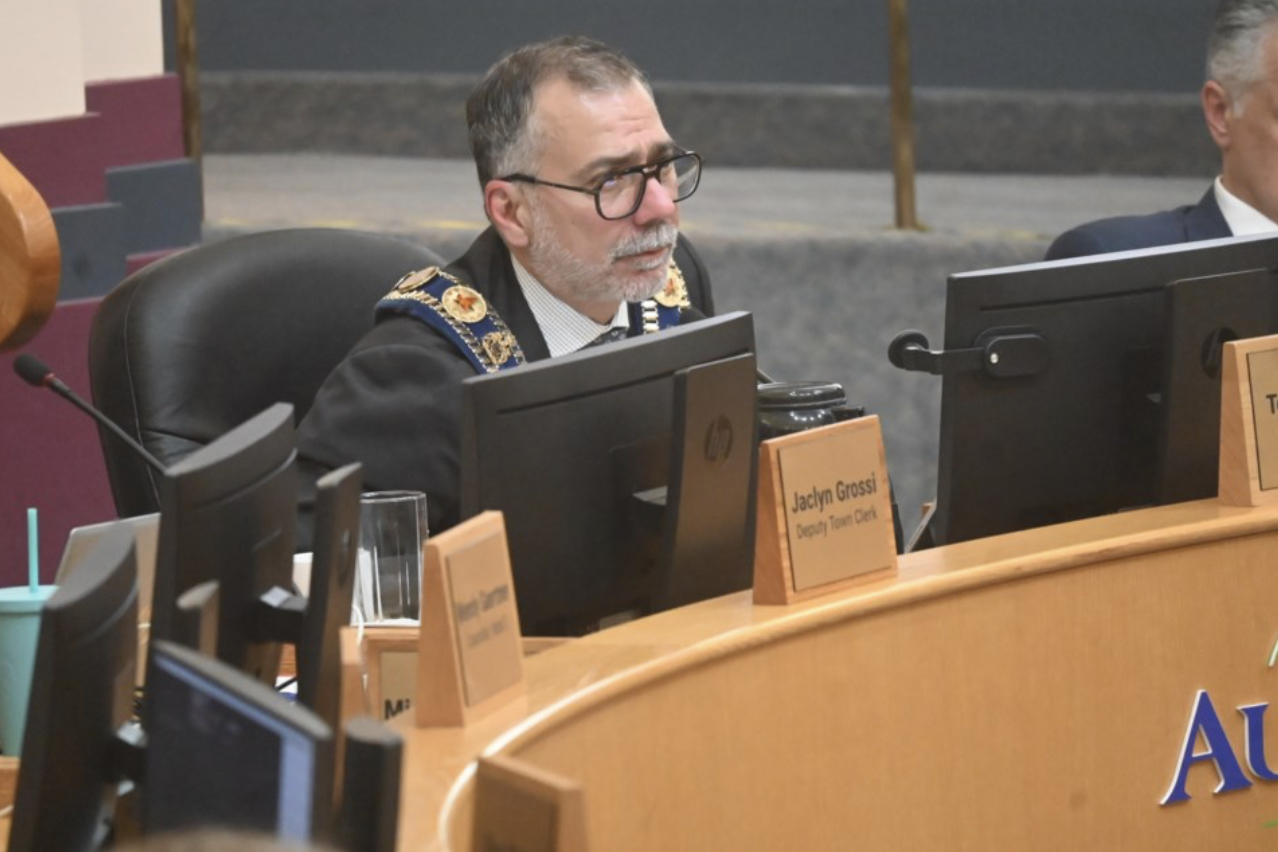Why shouldn’t municipalities be given powers to build homes for those in housing need? 
That’s the question being asked by Richmond Hill’s Joe DiPaola, and why not?
Governments have long since left the field to the private sector which is, for a million and one reasons, happier building monster homes rather than the more modest affordable ones.
The Man with the Plan
Step forward Joe Di Paola, the man with the plan.
DiPaola is married to Charity McGrath who was once a wannabe Progressive Conservative MPP for Newmarket-Aurora. But her Parliamentary ambitions turned to dust after she was accused of dirty tricks by fellow conservatives in trying to secure the PC nomination.
In any event, Joe DiPaola is saying some interesting things. And we should listen.
At York Region’s Committee of the Whole on 7 March 2024 in a debate on homelessness DiPaola joined Newmarket’s John Taylor in calling for vigorous action to tackle the crisis in housing affordability and the relentless rise in homelessness.
Last month Taylor told Regional councillors the number of people experiencing homelessness was growing exponentially.
He warned that without drastic action there would be tent encampments all over York Region within three to five years.
A report from Region’s Commissioner of Community Services and Chief Planner underlined the scale of the problem:
“Demand for subsidized housing continues to grow with 2,400 new eligible applications added to the Region’s subsidized waiting list in 2022 and the supply is not keeping up. As of December 31, 2022 there were 14,867 households on the subsidized waiting list with about 371 applicants housed annually on average between 2008 and 2022.”
Allow municipalities to build affordable homes
DiPaola’s solution is for the Province to allow municipalities to build affordable homes. He talks about the possibilities in Richmond Hill:
“We have a 20-acre parcel that we owned for a Civic Centre on Young St and Major Mackenzie. And we've abandoned a $220 million Civic Centre. We don't need that office space. It’s not required like we thought it was. And we have an opportunity. The only thing we have proposed is a park.
“If municipalities were allowed we could take 5 acres, build 2,000 units. It would cost about $600 million. We would be able to offer them at $800 a unit per month to people and then break even. Because we're not paying for the land. We're not paying for the financing costs. We have the money.
“We have over $350 million in reserves in Richmond Hill. We could dip into that as long as we're assured that we get that stream of income. If we were allowed to be the builders we could solve the problem.
Practical Plan
DiPaola refers to the elephant in the room. Everyone is saying the right things but no-one has a practical plan to tackle the problem. He says his Richmond Hill example could be applied in York region and across the Province.
“The Region's resources are far greater than Richmond Hill. But if the provincial government allowed municipalities - solely for the purpose of providing housing for their vulnerable residents - where we're allowed to take our property and build… within a strict regulated formula and using the list of people that are already qualified as the most in need for housing. We have a list there. Built the units and start to put people into units that we supply.
“In the 70s and 80s we never had this problem because the federal government realized that housing was important and they built subsidized housing for people who weren't able to afford it themselves. Now they're unwilling to. It seems like the Province is also unwilling. I think we have the ability. Why don't we just take on the role of creating subsidized housing in our region and house people who need to be housed?
“I think we could do 10,000 to 20,000 units in the next three to five years and we could fund it in a way that doesn't even impact our financial positions - both the nine local municipalities and the region using land that we own on key transportation corridors. It can be done.”
Fundamental Disagreements 
Debates at York Region rarely involve members challenging their colleagues on what they have to say. That’s not the way they do things. Most criticism is indirect and sotto voce. No-one wants to cause offence or unpleasantness by fundamentally disagreeing with a colleague’s position. “Debates” are nuanced affairs.
So I don’t know what other members of the Regional Council thought of Joe DiPaola’s thought-provoking contribution.
But this was Markham Mayor Frank Scarpitti's veiled rebuke:
“We, the Region and our local municipalities, are absolutely not equipped to spend the millions of dollars that are required to address homelessness.”
This is the same Frank Scarpitti who voted against a Vacant Property Tax in York Region on the grounds it would infringe property rights and be the thin end of the wedge.
Tom Mrakas
Now our gaze turns to Thursday, 11 April 2024.
That’s when Aurora’s stridently populist Mayor Tom Mrakas will tell the Region’s Committee of the Whole that homeless people should move in to York Region’s underused public buildings such as their brand new HQ on Yonge Street.
I’m waiting to hear from the Region if Tom ever asked them to look for an alternative location for the shelter in Aurora that has given him so many headaches.
I am assuming the Mayor has already prepared for the inevitable question in everyone’s mind next Thursday – even if it is not articulated.
Has he reviewed all the buildings owned by his own municipality – including Aurora Town Hall – to see if there is any space there to accommodate the homeless?
This email address is being protected from spambots. You need JavaScript enabled to view it.
See also from York Region: Affordable Private Market Housing Implementation Plan; Community Housing Development Master Plan and Homelessness in York Region and Development of Homelessness Service System Plan
Click below for more from Joe DiPaola. He says municipalities are allowed to build elaborate luxury indoor swimming pools and tennis courts and community centres but not the homes that people need. A typical subdivision community centre comes in at $200M.
Regional Councillor Joe DiPaola speaking at York Region's Committee of the Whole on 7 March 2024:
“I think we have to stop asking for money from the province and the feds. I think we have to start asking for legislative cooperation so that we can do more. Because I think there's a willingness to do more here. And right now we're allowed to build elaborate luxury indoor swimming pools and tennis courts and community centres that right now are costing… you know the last estimate we had for a community centre if we just do things the way we always do it… have a new subdivision and a community centre… $200 million estimate for a typical subdivision community centre.
We can't just continue to do things as we always did. Every 2000 new homes gets this expensive community centre. That $200 million represents about 700 units that could be built, according to market standards, what the market would currently offer in the 600-800 square foot range. If you can take the financing cost, the land cost, the municipal and government service cost - it's about half, about 50% or more of the cost of providing condo units… so we as municipalities in theory could build housing at 50% of the cost of what it would take someone who wants profit as well.
I mean someone who's looking for profit - the land cost, the financing costs and the municipal and other government service, you know, building fee costs… are well over 50%. So we could build homes at half price compared to the private sector. It would be wonderful to offer half price and then Housing York comes in on top of that with a subsidy but I'm not suggesting using taxpayers’ money. I'm suggesting that municipalities fully recover 100% of whatever they outlay initially, that we cost recover at 100%... and we're not looking to make profit but we're not spending tax dollars.
When we build a community centre we’re spending that $100M or $200M and it's gone. It’s out the window. It’s all capital. We're hoping that maybe the operating costs can be covered year to year.
The operating costs can be recovered by programs… it doesn’t in our case generally… but that capital is gone. And let's just change what we're doing. Let's recognize the reality of today and the next time we spend $200 million let’s not do it on a swimming pool. Let's do it on some units.
CHECK AGAINST DELIVERY
